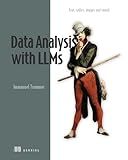Best Data Manipulation Tools to Buy in December 2025

Data Analytics Essentials You Always Wanted To Know : A Practical Guide to Data Analysis Tools and Techniques, Big Data, and Real-World Application for Beginners



Statistics: A Tool for Social Research and Data Analysis (MindTap Course List)



Data Analysis with LLMs: Text, tables, images and sound (In Action)



The Data Economy: Tools and Applications



Data Analysis with Open Source Tools: A Hands-On Guide for Programmers and Data Scientists



Advanced Data Analytics with AWS: Explore Data Analysis Concepts in the Cloud to Gain Meaningful Insights and Build Robust Data Engineering Workflows ... (Data Analyst — AWS + Databricks Path)



Python Tools for Scientists: An Introduction to Using Anaconda, JupyterLab, and Python's Scientific Libraries


To get a percentage of a Pandas DataFrame, you can use various methods depending on what exactly you want to calculate. Here are a few common scenarios:
- Row percentage: To calculate the percentage of each row relative to its sum, you can utilize the div function along with the sum function and set the axis parameter to 1. This will divide each element in a row by the sum of that row and give you the percentage.
- Column percentage: To find the percentage of each column relative to its sum, you can again use the div function along with the sum function, but this time set the axis parameter to 0. This will provide the percentage of each element in a column related to the sum of that column.
- Total percentage: If you want to calculate the percentage of each element relative to the total sum of the DataFrame, you can divide each element by the sum of the entire DataFrame.
These methods allow you to calculate percentages across rows, columns, or the entire DataFrame based on your specific requirements.
What is the technique to calculate the percentage of unique values in each column of a Pandas dataframe?
To calculate the percentage of unique values in each column of a Pandas dataframe, you can use the following technique:
import pandas as pd
Create a sample dataframe
data = {'Column1': ['A', 'B', 'C', 'A', 'B'], 'Column2': [1, 2, 3, 1, 2], 'Column3': [True, False, True, True, False]} df = pd.DataFrame(data)
Calculate the percentage of unique values in each column
percentage_unique = df.nunique() / len(df) * 100
print(percentage_unique)
Output:
Column1 60.0 Column2 60.0 Column3 40.0 dtype: float64
In this example, we first create a sample dataframe df with three columns. Then, we use the nunique() function on the dataframe to calculate the number of unique values in each column. Finally, we divide the number of unique values by the length of the dataframe and multiply it by 100 to get the percentage of unique values in each column. The resulting percentages are printed as a Pandas Series.
How to calculate the percentage contribution of each category in a Pandas dataframe column?
To calculate the percentage contribution of each category in a Pandas DataFrame column, you can follow these steps:
- Start by importing the necessary libraries: pandas and numpy. import pandas as pd import numpy as np
- Create a DataFrame with the required data. For example: data = {'Category': ['A', 'A', 'B', 'B', 'C', 'C'], 'Value': [10, 20, 30, 40, 50, 60]} df = pd.DataFrame(data)
- Group the DataFrame by the desired column (in this case, 'Category') and calculate the sum of values for each category: category_sum = df.groupby('Category')['Value'].sum()
- Calculate the total sum of values in the column: total_sum = df['Value'].sum()
- Calculate the percentage contribution using the formula: (category_sum / total_sum) * 100 and round the values to the desired number of decimal places: percentage_contribution = (category_sum / total_sum) * 100 percentage_contribution = percentage_contribution.round(2)
- (Optional) If you want to add the percentage contribution values as a new column in the DataFrame, you can use the pandas merge() function: df = df.merge(percentage_contribution, left_on='Category', right_index=True) df.rename(columns={'Value_x': 'Value', 'Value_y': 'Percentage Contribution'}, inplace=True)
Here's the complete example with all the steps put together:
import pandas as pd import numpy as np
data = {'Category': ['A', 'A', 'B', 'B', 'C', 'C'], 'Value': [10, 20, 30, 40, 50, 60]} df = pd.DataFrame(data)
category_sum = df.groupby('Category')['Value'].sum() total_sum = df['Value'].sum()
percentage_contribution = (category_sum / total_sum) * 100 percentage_contribution = percentage_contribution.round(2)
df = df.merge(percentage_contribution, left_on='Category', right_index=True) df.rename(columns={'Value_x': 'Value', 'Value_y': 'Percentage Contribution'}, inplace=True)
print(df)
This will give you the DataFrame with the 'Percentage Contribution' column added, showing the percentage contribution of each category in the 'Value' column.
How to calculate the percentage of zero values in a Pandas dataframe column?
To calculate the percentage of zero values in a pandas DataFrame column, you can follow the steps below:
- Count the number of zeros in the column using the eq() function. This function checks if each value in the column equals zero and returns a boolean Series.
- Use the sum() function to count the number of True values (zeros) in the boolean Series.
- Divide the count of zeros by the total number of values in the column and multiply by 100 to get the percentage.
Here is an example of how you can do this:
import pandas as pd
create a sample DataFrame with a column containing zeros
data = {'column_name': [0, 1, 0, 0, 2, 3, 0, 4, 0]} df = pd.DataFrame(data)
count the number of zeros and calculate the percentage
zero_count = df['column_name'].eq(0).sum() total_count = len(df) percentage_of_zeros = (zero_count / total_count) * 100
print("Percentage of zero values in the column:", percentage_of_zeros)
Output:
Percentage of zero values in the column: 55.55555555555556
In this example, the column 'column_name' has 5 zero values out of the total 9 values, resulting in a percentage of approximately 55.56%.
How to normalize the values in a Pandas dataframe column to percentages?
To normalize the values in a Pandas DataFrame column to percentages, you can follow these steps:
- Import the required libraries:
import pandas as pd
- Create a DataFrame with the desired values:
data = {"col1": [10, 20, 30, 40, 50], "col2": [100, 200, 300, 400, 500]} df = pd.DataFrame(data)
- Calculate the sum of the column you want to normalize:
sum_col = df['col1'].sum()
- Use the apply function along with a lambda function to normalize the values:
df['col1_normalized'] = df['col1'].apply(lambda x: (x / sum_col) * 100)
- Print the resulting DataFrame:
print(df)
The output will be:
col1 col2 col1_normalized 0 10 100 6.666667 1 20 200 13.333333 2 30 300 20.000000 3 40 400 26.666667 4 50 500 33.333333
In this example, the values in the 'col1' column are normalized to percentages and stored in a new column called 'col1_normalized'. Each value is divided by the sum of the 'col1' column, multiplied by 100 to get the percentage, and assigned to the corresponding row in the 'col1_normalized' column.
